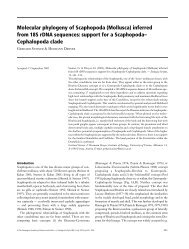Gnathostomulida—An Enigmatic Metazoan Phylum from both ...
Gnathostomulida—An Enigmatic Metazoan Phylum from both ...
Gnathostomulida—An Enigmatic Metazoan Phylum from both ...
You also want an ePaper? Increase the reach of your titles
YUMPU automatically turns print PDFs into web optimized ePapers that Google loves.
Phylogenetic Solution<br />
relationship in a wider metazoan context, and each<br />
author has provided some morphological interpretation<br />
of the association, which in turn may serve to warrant a<br />
reevaluation of the gnathostomulids. We believe the<br />
notion of gnathostomulids as members of the Ecdysozoa<br />
is not outlandish and without recourse to molecular<br />
systematics, such an affinity may have been overlooked.<br />
As early as 1886, Schneider recognized a chaetognath–nematode<br />
association based on a perceived homology<br />
between the arrangement of their muscular bands,<br />
and Metschnikov (1867) drew attention to the affinities<br />
of certain marine free-living nematodes and the chaetognaths<br />
(cited in Ghirardelli, 1968, p. 356). Halanych<br />
(1996, p. 232) speculated that ‘‘the node defined by the<br />
last common ancestor of chaetognaths and nematodes<br />
may include other metazoan taxa that were not examined<br />
in this study (e.g., Nematomorpha and Gastrotricha).’’<br />
Our analyses have included these taxa and<br />
although the gastrotrichs were resolved as sister-group<br />
to the flatworms (Rhabditophoran platyhelminths), the<br />
nematomorphs (Gordius) did appear to share a common<br />
ancestor with the nematodes and chaetognaths. Is<br />
the position of the gnathostomulids, as a member of the<br />
nematodes � chaetognaths clade, an artifact?<br />
In all of our analyses, the branches leading to the<br />
nematodes, chaetognaths, and Gnathostomula are long<br />
and the competing morphologically based phylogenies,<br />
although less well supported, were not statistically<br />
different <strong>from</strong> our solutions based on maximumparsimony<br />
or neighbor-joining methods. Rather than<br />
analyze the data further it seems clear that these three<br />
phyla need to be sampled more densely in an attempt to<br />
find representative taxa with shorter branches. However,<br />
as Telford and Holland (1997) recently noted,<br />
extant chaetognaths probably underwent a recent rapid<br />
radiation and it is unlikely that denser sampling will<br />
split these long branches. Similarly, until more (freeliving<br />
and parasitic) nematodes are sampled we are<br />
AFFINITIES OF THE GNATHOSTOMULIDA<br />
TABLE 2<br />
Tree Statistics for Unconstrained and Constrained Phylogenetic Solutions<br />
Maximum Parsimony Minimum evolution<br />
No. trees Length CI RI �ln ME<br />
Unconstrained 60 3081 0.352 0.542 15,746.4 2.256<br />
Ecdysozoa 4 3082 0.352 0.542 15,746.4 2.256<br />
Gnathifera 8 3083 0.352 0.542 15,746.0 2.269<br />
Plathelminthomorpha 86 3087 0.351 0.541 15,776.7 2.267<br />
Note. Constraints forced monophyletic groupings of Gnathostomula � Platyhelminthes (Plathelminthomorpha, sensu Ax 1996), Gnathostomula<br />
� Acanthocephala � Rotifera (Gnathifera, sensu Haszprunar 1996) and, as suggested by the minimum evolution model, Gnathostomula<br />
� Arthropoda � Chaetognatha � Nematoda � Kinorhyncha � Nematomorpha (Ecdysozoa, sensu Aguinaldo et al. 1997; see also<br />
Eernisse, 1997). For the distance method NJ was used employing the LogDet/paralinear model followed by multiple iterative remodeling<br />
under a maximum-likelihood model. CI, consistency index excluding uninformative sites; RI, retention index; -ln, log likelihood; ME,<br />
minimum evolution score.<br />
unable to avoid the long-branch problem with nematodes<br />
(Aguinaldo et al., 1997).<br />
Until such time that the long branch problem can be<br />
addressed, our data suggest that certain morphological<br />
features might benefit <strong>from</strong> reevaluation. Halanych<br />
(1996) provided an evolutionary scenario for the origin<br />
of the chaetognath � nematode lineage and some<br />
striking similarities appear between the putative ancestor<br />
and the gnathostomulids. It was argued that the<br />
ancestor would possibly be vermiform and benthic,<br />
with enlarged or hardened modified feeding structures<br />
to subdue prey quickly. Gnathostomulids are active<br />
interstitial, marine grazers and possess sceloritized,<br />
cuticular jaws and a basal plate against which the jaws<br />
work. These features alone do not persuade an acceptance<br />
of the new hypothesis and, like all molecular<br />
systematic studies, the strength of interpretation relies<br />
on comparative morphological data to make biological<br />
sense.<br />
In the early days of molecular systematics 18S rDNA<br />
was hailed as the one gene which would provide an<br />
answer to metazoan interrelationships. It is unlikely<br />
that any single gene will yield a robust or biologically<br />
plausible metazoan phylogeny when all major clades<br />
have been sampled sufficiently. While it is unable to<br />
provide complete resolution, 18S rDNA does still have<br />
the power to allow to us assess and reconsider some of<br />
the more tenuous morphologically based scenarios.<br />
ACKNOWLEDGMENTS<br />
This work was funded by a Wellcome Trust Senior Research<br />
Fellowship in Biodiversity to D.T.J.L. (043965/Z/95/Z) that also<br />
supported K.A.C.; M.J.T. invested valuable free time. Kerstin Wasson<br />
kindly provided us with specimens of Barentsia, Robert Hirt and<br />
Bland Finlay provided the Chaetonotus, and Anno Faubel identified<br />
the gnathostomulids. We thank David Swofford for providing a<br />
prerelease version of PAUP* and George Shinn for his views on the<br />
chaetognath/nematode clade.<br />
77








